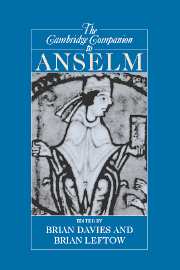Book contents
- Frontmatter
- Introduction
- 1 Anselm’s life, works, and immediate influence
- 2 Anselm on faith and reason
- 3 Anselm, Augustine, and Platonism
- 4 Anselm’s philosophy of language
- 5 Anselm on modality
- 6 Anselm’s perfect-being theology
- 7 Anselm and the ontological argument
- 8 Anselm’s account of freedom
- 9 Anselm on truth
- 10 Anselm on ethics
- 11 Anselm on the Trinity
- 12 Anselm on atonement
- Bibliography
- Index
2 - Anselm on faith and reason
Published online by Cambridge University Press: 28 May 2006
- Frontmatter
- Introduction
- 1 Anselm’s life, works, and immediate influence
- 2 Anselm on faith and reason
- 3 Anselm, Augustine, and Platonism
- 4 Anselm’s philosophy of language
- 5 Anselm on modality
- 6 Anselm’s perfect-being theology
- 7 Anselm and the ontological argument
- 8 Anselm’s account of freedom
- 9 Anselm on truth
- 10 Anselm on ethics
- 11 Anselm on the Trinity
- 12 Anselm on atonement
- Bibliography
- Index
Summary
INTRODUCTION
When contemporary philosophers probe the relation between faith and reason, their focus is on the propositional content of religious belief. They ask whether doctrinal propositions can be proved by sound arguments from premises acceptable to unbelievers, or, failing that, whether adherence to such theses can be rationally justified. Christian philosophers often see themselves as responding to pressure from the outside to defend the rationality of Christian faith. In the waning years of the Roman empire, St. Augustine, too, was preoccupied with defending the faith, first externally, against its pagan competitors (not only but principally the Manichaeans); then against heretics (Donatists and Pelagians) within.
St. Anselm’s eleventh-century situation was different from both of these. He spent most of his life in the Benedictine Monastery at Bec. Most of his works were penned for and at the behest of his monastic brother-students. Their overarching common aim was to become persons who could see and enjoy God’s face. Their intellectual pursuits were integrated into that project. Anselm’s written investigations of non-theological subjects were all occasioned by the exigencies of their doctrinal inquiries. These facts about Anselm’s career have left deep imprints on his philosophical theology, not least on his method. If he was eventually drawn into polemical contexts and confronted with real non-Christians, Anselm continued to see the drive to understand Christian faith by reason alone (sola ratione) as predominantly internal, arising not simply from his own monastic vocation, but from the natural teleology built into human nature itself.
- Type
- Chapter
- Information
- The Cambridge Companion to Anselm , pp. 32 - 60Publisher: Cambridge University PressPrint publication year: 2004
- 7
- Cited by

